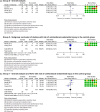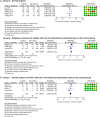Endometrial scratching prior to IVF; does it help and for whom? A systematic review and meta-analysis
- PMID: 30895265
- PMCID: PMC6396643
- DOI: 10.1093/hropen/hoy025
Endometrial scratching prior to IVF; does it help and for whom? A systematic review and meta-analysis
Abstract
Study question: What is the effect of endometrial scratching in patients with or without prior failed ART cycles on live birth (LBR) and clinical pregnancy rates (CPR)?
Summary answer: It remains unclear if endometrial scratching improves the chance of pregnancy and, if so, for whom.
What is known already: Endometrial scratching is hypothesized to improve embryo implantation in ART. Multiple studies have been published, but it remains unclear if endometrial scratching actually improves pregnancy rates and, if so, for which patients.
Study design size duration: For this review, a systematic search for published articles on endometrial scratching and ART was performed on 12 February 2018, in Pubmed, Embase and the Cochrane Library.
Participants/materials setting methods: Randomized controlled trials (RCTs) that evaluated endometrial scratching in the cycle prior to the stimulation cycle and reported CPR or LBR were included. RCTs investigating the effect of scratching during the stimulation cycle, or prior to cryo-thaw cycles were excluded. Studies were assessed using the Cochrane Risk of Bias tool. The effect of scratching was assessed for three different patient groups: patients with no prior IVF/ICSI treatment (Group 0), patients with one failed full IVF/ICSI cycle, including cryo-thaw cycles (Group 1) and patients with two or more failed full IVF/ICSI cycles (Group 2). A meta-analysis was performed when statistical heterogeneity was low; otherwise, a descriptive analysis was performed.
Main results and the role of chance: Fourteen RCTs involving 2537 participants were included. Most RCTs contained a high or unclear risk of bias on one or more items. Substantial clinical and statistical heterogeneity was present; therefore meta-analysis for LBR and CPR could only be performed on Group 1. For this group, no differences between scratch and control were found for both LBR (risk ratio (RR) 1.01 [95%CI 0.68-1.51]) and CPR (RR 1.04 [95%CI 0.74-1.45]). For Groups 0 and 2, pooled analysis could not be performed, and for both groups the results of the individual RCTs were negative, neutral and positive. Miscarriage and multiple pregnancy rates were evaluated for the three groups (0, 1 and 2) together. Both outcomes were not significantly different between scratch and control (miscarriage rate RR 0.82 [95%CI 0.57-1.17] and multiple pregnancy rate RR 1.06 [95%CI 0.84-1.35]). Subgroup analysis, excluding trials with a risk of unintentional endometrial injury in the control group, was performed for Group 0 and 2 for LBR and CPR, and for the overall groups for miscarriage rate and multiple pregnancy rate. This reduced the heterogeneity and allowed for pooled analysis in these subgroups. Results of pooled analysis for the subgroups of Group 0 and 2 showed no significant difference for LBR, but CPR was significantly improved after endometrial scratching (Group 0 RR 1.28 [95%CI 1.02-1.62] and Group 2 RR 2.03 [95%CI 1.20-3.43]). Subgroup analysis of the overall groups showed no significant difference for miscarriage and multiple pregnancy rate.
Limitations reasons for caution: The main limitations were that many RCTs had a high or unclear risk of bias on one or several items, clinical heterogeneity was still present despite categorizing into three populations, and that not all RCTs could be included in the analyses because separate data for our three groups could not be provided.
Wider implications of the findings: It remains unclear if endometrial scratching improves the chance of pregnancy for women undergoing ART and, if so, for whom. This means endometrial scratching should not be offered in daily practice until results from large and well-designed RCTs and an individual patient data analysis become available.
Study funding/competing interests: No specific funding was sought for the study. The Department of Reproductive Medicine and Gynaecology funds of the University Medical Center of Utrecht were used to support the authors throughout the study period and preparation of the manuscript. None of the authors has a conflict of interest to declare.
Registration number: Not applicable.
Keywords: ART; ICSI; IVF; embryo implantation; endometrial injury; endometrial scratching; implantation failure.
Figures







References
-
- Barash A, Dekel N, Fieldust S, Segal I, Schechtman E, Granot I. Local injury to the endometrium doubles the incidence of successful pregnancies in patients undergoing in vitro fertilization. Fertil Steril 2003;6:1317–1322. - PubMed
-
- Baum M, Yerushalmi GM, Maman E, Kedem A, MacHtinger R, Hourvitz A, Dor J. Does local injury to the endometrium before IVF cycle really affect treatment outcome? Results of a randomized placebo controlled trial. Gynecol Endocrinol 2012;12:933–936. - PubMed
-
- Boivin J, Bunting L, Collins JA, Nygren KG. International estimates of infertility prevalence and treatment-seeking: potential need and demand for infertility medical care. Hum Reprod 2007;6:1506–1512. - PubMed
-
- Borenstein M, Hedges LV, Higgins JP, Rothstein HR. A basic introduction to fixed-effect and random-effects models for meta-analysis. Res Synth Methods 2010;2:97–111. - PubMed
-
- Chatters R. Endometrial Scratch Trial (ISRCTN 23800982). 2017; Available at: www.isrctn.com. Accessed January 7, 2019.
Publication types
LinkOut - more resources
Full Text Sources
Research Materials
